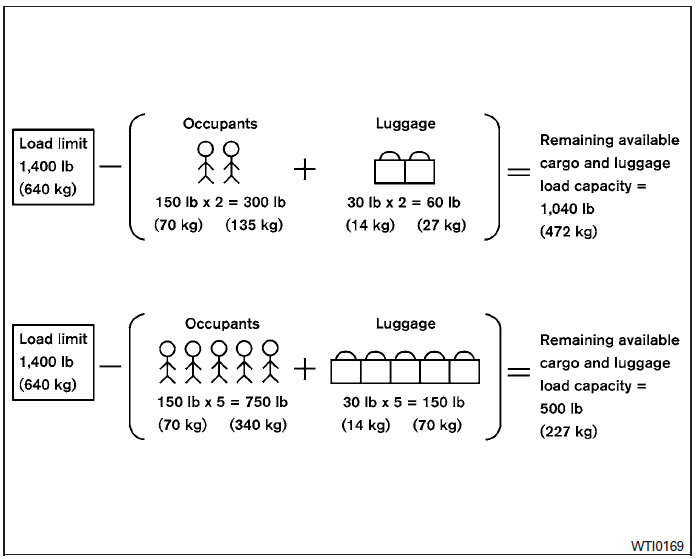Nissan Sentra Owners Manual: Vehicle load capacity
Do not exceed the load limit of your vehicle shown as ŌĆ£The combined weight of occupants and cargoŌĆØ on the Tire and Loading Information label. Do not exceed the number of occupants shown as ŌĆ£Seating CapacityŌĆØ on the Tire and Loading Information label.
To get ŌĆ£the combined weight of occupants and cargoŌĆØ, add the weight of all occupants, then add the total luggage weight. Examples are shown in the following illustration.

Example
Steps for determining correct load limit
- Locate the statement ŌĆ£The combined weight of occupants and cargo should never exceed XXX lbs or XXX kgŌĆØ on your vehicleŌĆÖs placard.
- Determine the combined weight of the driver and passengers that will be riding in your vehicle
- Subtract the combined weight of the driver and passengers from XXX lbs or XXX kg.
- The resulting figure equals the available amount of cargo and luggage load capacity. For example, if the XXX amount equals 1,400 lbs. and there will be five 150 lb. passengers in your vehicle, the amount of available cargo and luggage load capacity is 650 lbs. (1,400-750 (5 X 150) = 650 lbs) or (640-340 (5 X 70) = 300 kg.)
- Determine the combined weight of luggage and cargo being loaded on the vehicle. That weight may not safely exceed the available cargo and luggage load capacity calculated in Step 4.
- If your vehicle will be towing a trailer, load from your trailer will be transferred to your vehicle. Consult this manual to determine how this reduces the available cargo and luggage load capacity of your vehicle.
Before driving a loaded vehicle, confirm that you do not exceed the Gross Vehicle Weight Rating (GVWR) or the Gross Axle Weight Rating (GAWR) for your vehicle.
See ŌĆ£Measurement of weightsŌĆØ in this section.
Also check tires for proper inflation pressures.
See the Tire and Loading Information label.
 Terms
Terms
It is important to familiarize yourself with
the following terms before loading your
vehicle:
Curb Weight (actual weight of your
vehicle) - vehicle weight including:
standard and optional eq ...
 Loading tips
Loading tips
The GVW must not exceed GVWR
or GAWR as specified on the
F.M.V.S.S./C.M.V.S.S. certification
label.
Do not load the front and rear axle to
the GAWR. Doing so will exceed the
GVWR.
...
Other materials:
Towing a trailer
Do not tow a trailer with your vehicle.
Flat towing
Towing your vehicle with all four wheels on the
ground is sometimes called flat towing. This
method is sometimes used when towing a vehicle
behind a recreational vehicle, such as a motor
home.
CAUTION
Failure to follow these guidelines c ...
How to use this manual
How to use this section
Information
ą▓ąéčÜCaną▓ąéč£ of lan section describes information peculiar to a vehicle and
inspection procedures.
For trouble diagnosis procedure, refer to lan-16, "trouble diagnosis
flow chart" of ą▓ąéčÜcan fundamentalą▓ąéč£.
Abbreviation list
Unit ...
Parking, license plate and tail
lamps are not turned on
Description
The parking, license plate and tail lamps do not turn on in with any lighting
switch setting.
Diagnosis procedure
1.Combination switch (lighting and turn signal switch) inspection
Check the combination switch (lighting and turn signal switch). Refer to
BCS-72, "Symptom Table ...
